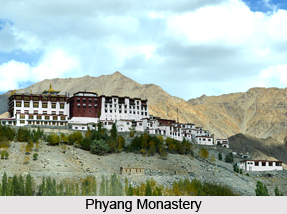 Phyang monastery also called `Phyang Gompa` is one of the oldest Buddhist monasteries in India. The name Phyang was derived from Gang Ngonpo that means the `blue mountain`, which is situated behind the monastery. Phyang is one of only two monasteries in Ladakh belonging to Dri-gung-pa sect of Tibetan Buddhism, one of eight schools derived from the teachings of Phakmadrupa Dorje Gyelpo.
Phyang monastery also called `Phyang Gompa` is one of the oldest Buddhist monasteries in India. The name Phyang was derived from Gang Ngonpo that means the `blue mountain`, which is situated behind the monastery. Phyang is one of only two monasteries in Ladakh belonging to Dri-gung-pa sect of Tibetan Buddhism, one of eight schools derived from the teachings of Phakmadrupa Dorje Gyelpo.
Location of Phyang Monastery
Phyang is located around 15 or 16 kilometres west of Leh in Ladakh region in Jammu and Kashmir in north India. It lies on the Leh-Kargil Road.
History of Phyang Monastery
As per legends, it was built by Choje Denma Kunga Drakpa in the 16th century with the sponsorship of his disciple Chogyal Tashi Namgyal. Tashi Namgyal was the 21st Dharma King of Ladakh. According to some other legends, the site where Phyang is now situated was once a part of the numerous monastic properties, offered during the time of Dharmaraja Jamyang Namgial to Chosje Damma Kunga.
Attractions of Phyang Monastery
Phyang gompa belongs to the Red Cap sect of the Buddhists. Hundreds of idols of Lord Buddha are neatly arranged on wooden shelves, a neat view to witness as visitors.
Besides all these, the monastery is also famous for housing attractive wall paintings, collections of old thangkas and murals of Mahakala. It has a 900-year-old museum containing ancient collection of idols including a number of fine Kashmiri bronzes probably dating to the 14th century, thangkas, Chinese, Tibetan and Mongolian firearms and weapons.
Inside the complex, an old temple of Mahakala was built at the time of the establishment of monastery. The monastery has a school to provide education and training in Buddhism. Classes offered include Tibetan, English, Hindi and mathematics. Presently, the monastery is home to 100 monks.
Festival of Phyang Monastery
Every year, Phyang monastery organizes a festival called `Gang-Sngon Tsedup festival`. It kick-starts from 17th day and continues till 19th day of the first month of the Tibetan calendar. Dance, music and mask dance are integral part of this age old festival. Another attraction of this festival is the `Cham dance` which is performed by the lamas.
Connectivity of Phyang Monastery
After November owing to the heavy snowfall, almost all of the entry points to Phyang remain closed. Thus, it is ideal to visit the monastery between May and September, when the weather remains warm.




